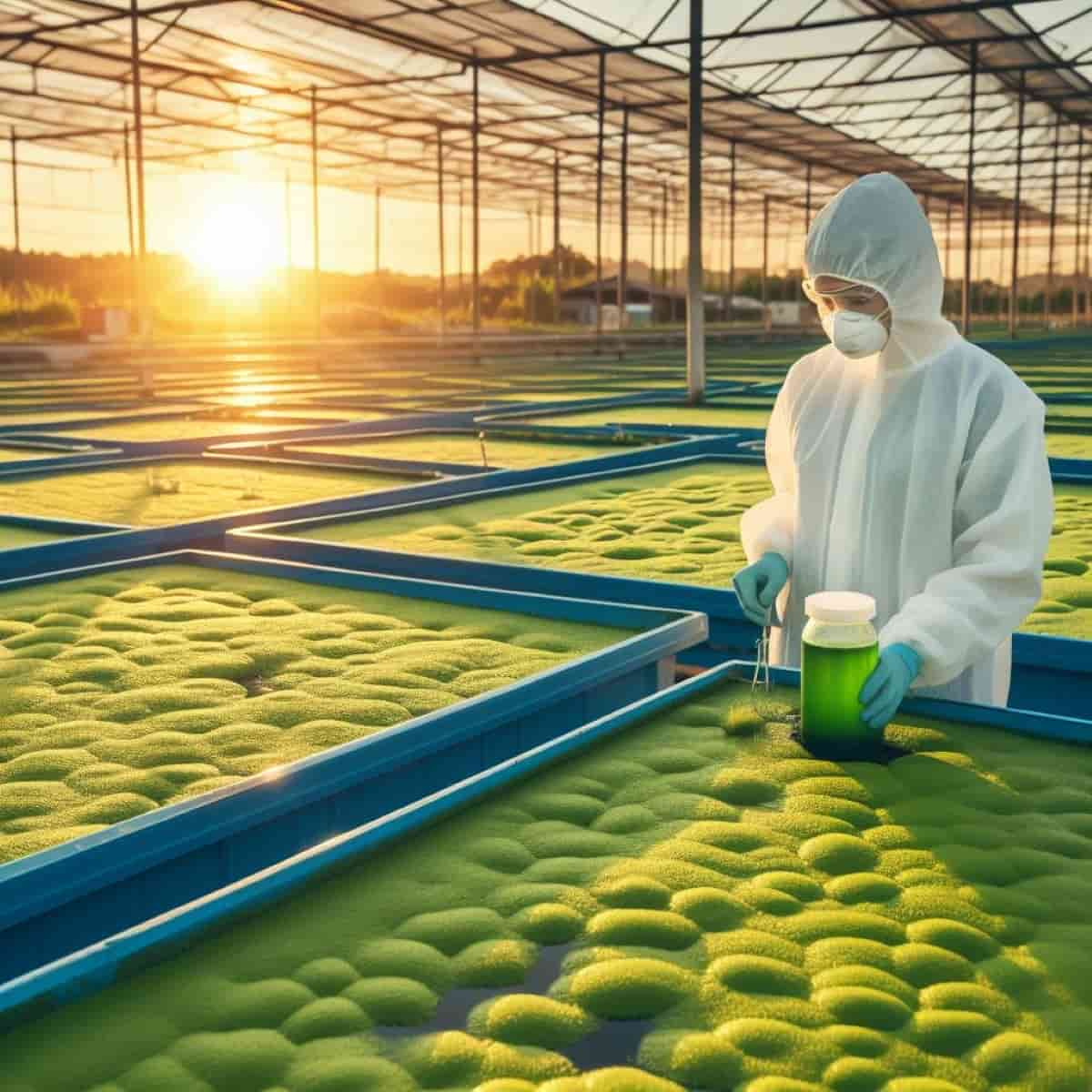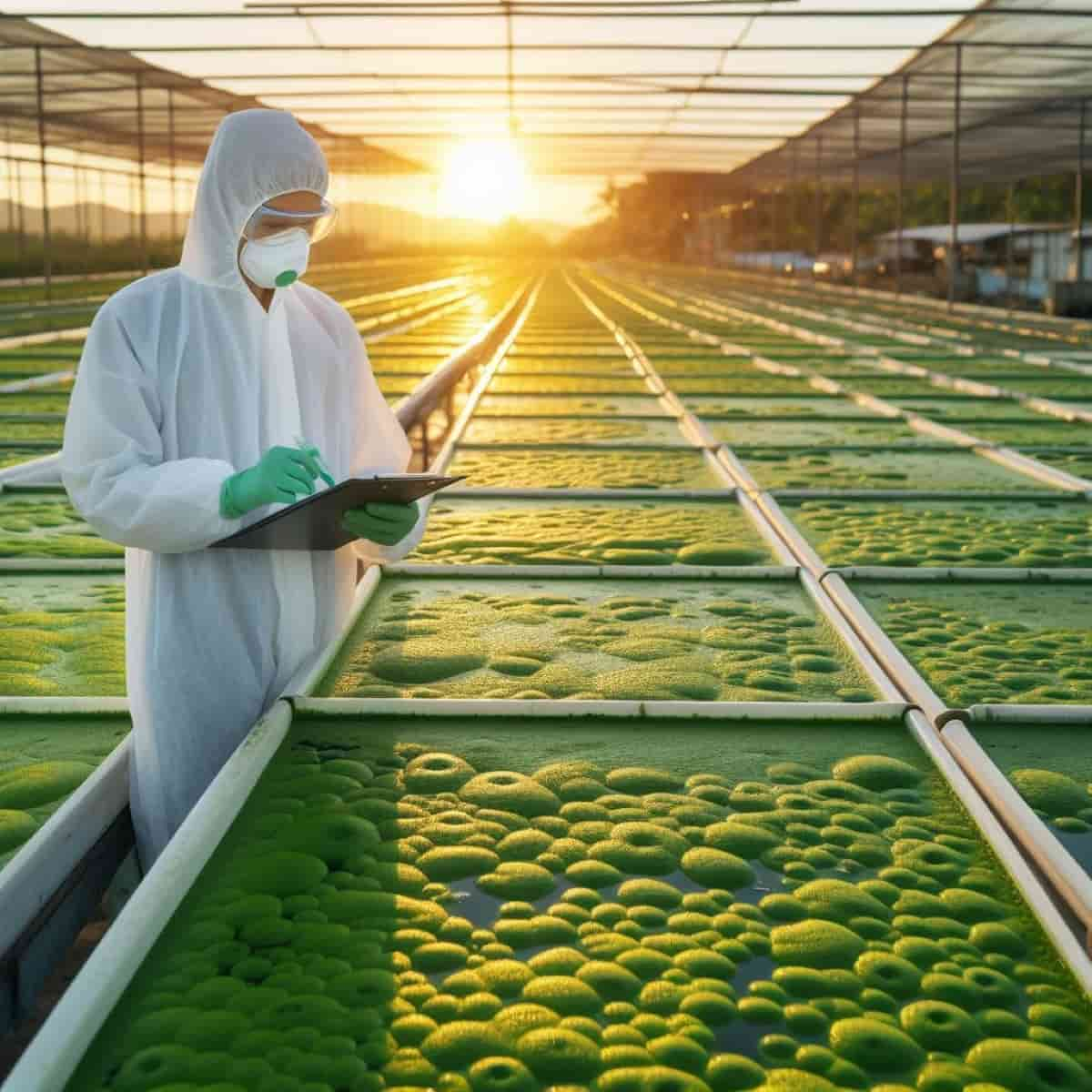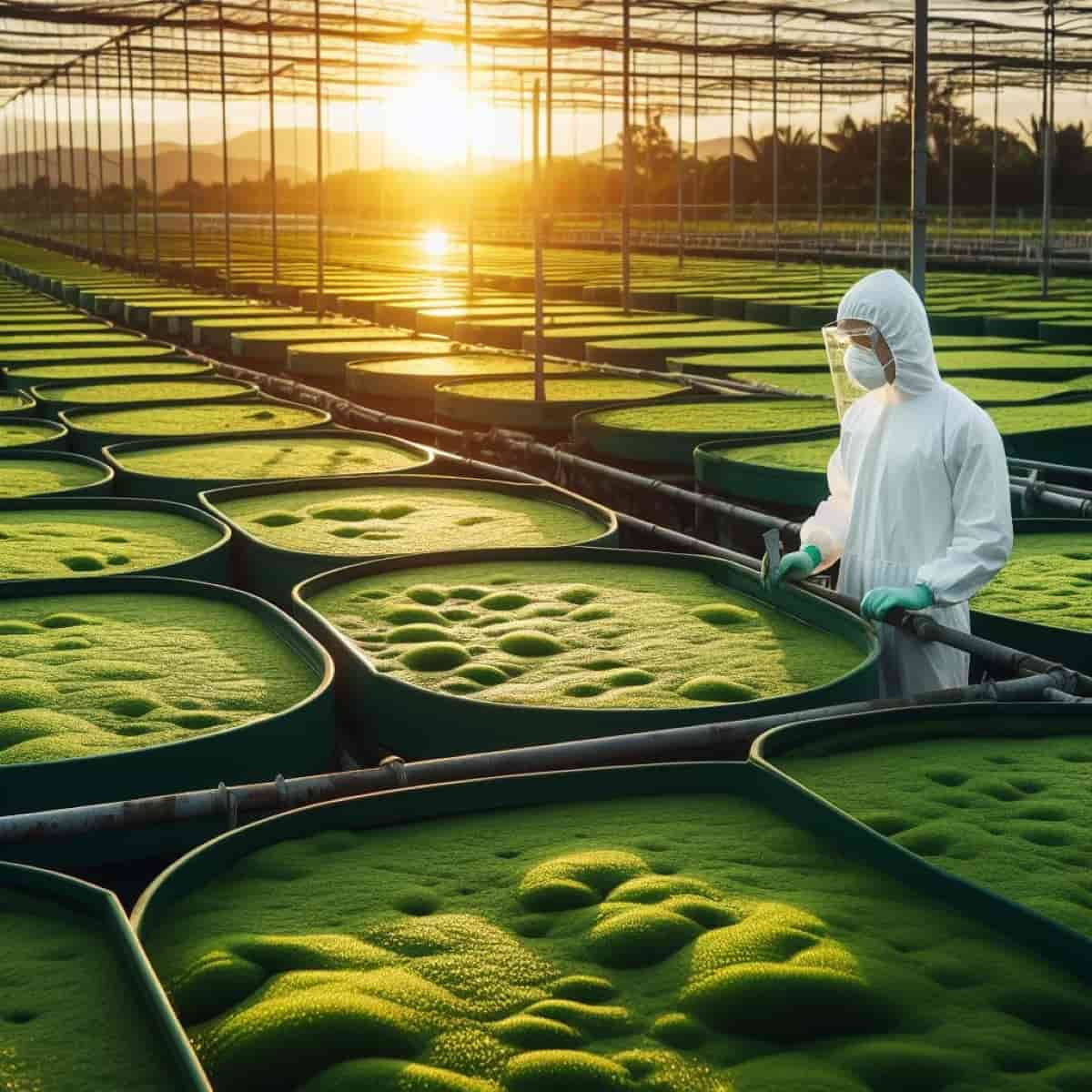Spirulina, a nutrient-rich algae, thrives in varied farming systems. This blog delves into effective methods to cultivate Spirulina, exploring diverse environments and techniques, ensuring a comprehensive guide for both novices and experts in this sustainable agriculture venture.

Spirulina Farming Systems
Open Pond System
Growing Spirulina in an open-pond system involves a few key steps. First, prepare a clean, shallow pond or tank with a transparent cover to allow sunlight, and equip it with a paddlewheel for water movement. The depth should be at least 20 cm, and the area should be a minimum of 1 square meter. Next, fill it with water at pH 10 and 10% salinity, adjusting these with baking soda and salt. Add nutrients like urea and iron sulfate to promote growth.
Inoculate the pond with a live spirulina culture, ensuring thorough mixing. Maintain optimal growth conditions: a temperature range of 30-35°C, sufficient sunlight, a pH around 10, appropriate salinity, and regular nutrient checks. These steps ensure healthy spirulina cultivation in open ponds.
Photobioreactor System
Growing Spirulina in a Photobioreactor (PBR) offers a controlled, efficient way to cultivate this beneficial algae. PBRs consist of a culture vessel, light source, and gas exchange system. Steps include preparing a nutrient-rich culture medium, inoculating with spirulina starter, providing light, and managing gas exchange for carbon dioxide and oxygen. Monitoring factors like temperature, pH, and nutrient levels is crucial.
Harvesting involves separating Spirulina from the medium. Benefits of PBR systems include higher yield and quality, improved growth condition control, reduced contamination risk, and lesser environmental impact. Challenges involve higher costs, increased energy needs, and technical complexities. PBRs present an advanced, effective method for spirulina cultivation, suitable for enthusiasts and professionals seeking high-quality production.
Raceway Pond System
The Raceway Pond System is a very effective aquaculture technique that was created especially for the development of Spirulina. It features circular, shallow water bodies that are often composed of concrete, where Spirulina grows in carefully regulated environments. The distribution of nutrients and light exposure, which are essential for spirulina development, may be optimized with the help of this method.
In case you missed it: Frequently Asked Questions About Spirulina Farming

With its paddlewheel shape, the raceway guarantees steady water flow, which deters sedimentation and encourages even algal dispersal. Because the thick biomass of Spirulina is readily gathered, this technique not only enhances spirulina productivity but also makes harvesting easier. Furthermore, the regulated atmosphere reduces the possibility of contamination, guaranteeing a harvest of pure Spirulina. Due to its scalability and affordability, this technique is widely used in the commercial production of Spirulina.
Indoor Controlled Environment System
Spirulina, a blue-green algae, is a potent superfood rich in proteins, antioxidants, and minerals. It’s known for reducing inflammation, lowering cholesterol, boosting immunity, and potentially preventing certain cancers. Growing Spirulina at home requires a clear tank, live culture starter, fertilizer, and a controlled environment system to maintain optimal growth conditions like temperature, light, pH, and salinity.
- Place the tank in a warm, bright location, away from direct sunlight, maintaining a temperature between 30-35°C.
- Use non-chlorinated, filtered water to avoid harmful chemicals.
- Add spirulina-specific fertilizer for necessary nutrients.
- Introduce live spirulina culture.
- Regularly monitor and adjust pH (around 9-10) and salinity (15-25 grams per liter).
- Harvest in 3-6 weeks using a fine mesh, rinsing and drying the algae for consumption.
Integrated Farming System
In order to maximize resource utilization and efficiency, growing Spirulina in an integrated farming system (IFS) involves combining it with other agricultural components. Nutrient-rich algae called Spirulina prefer alkaline water with a pH of 8–11, temperatures between 30 and 35°C, and plenty of sunshine.
Spirulina may be used with aquaculture in IFS since it uses the leftover nutrients from shrimp or fish farms to cleanse water and cut down on waste. Shallow ponds or tanks with regulated water circulation are necessary for its cultivation to provide uniform sun exposure. Given its rapid growth rate, harvesting is done on a frequent basis. In addition to increasing resource sustainability, this symbiosis in IFS diversifies agricultural output, raising total production and maintaining ecological balance.
Vertical Farming System
Utilizing a vertical farming system to grow Spirulina requires a complex strategy that optimizes nutrient supply and space efficiency. This technique, which piles growing trays or columns vertically, is well-known for enabling greater Spirulina growth in a smaller footprint—a significant advantage in urban or space-constrained environments.
Consistent monitoring of temperature, pH levels, nutrient concentrations, and water quality is essential for the optimal cultivation of Spirulina in this configuration. Spirulina needs a warm climate, preferably between 30 and 35°C, and prefers alkaline water with a pH of 8 to 11. Photosynthesis requires either regulated exposure to natural sunshine or artificial illumination.
Automated systems for water circulation and fertilizer delivery contribute to the maintenance of ideal growth conditions and a consistent supply of vital nutrients like potassium, phosphate, and nitrogen. Spirulina from vertical farms is harvested by carefully removing the biomass from the growing medium, drying it, and then processing it for a variety of applications.
Fermentation System
Spirulina grows more quickly and is pure in a controlled, sterile environment when it is grown in a fermentation system. First, choose an appropriate bioreactor and make sure it is sterile to avoid infection. Use a nutrient-rich medium that is specific to the demands of Spirulina, usually a blend of water, carbon sources, and minerals.
Harvesting involves removing the biomass of Spirulina from the media, which is often accomplished via filtering. The last step in post-harvest processing is to wash, dewater, and dry the Spirulina to get it ready for ingestion or further processing. High-quality Spirulina with regulated growth and reduced contamination concerns is produced using this technique.
Hybrid System
In order to maximize development conditions, a hybrid method for growing Spirulina combines artificial lighting with natural sunshine. Production may continue using this method regardless of the outside weather. First, an appropriate media that is suited to Spirulina’s requirements is chosen. This medium is usually a combination of water, minerals, and nutrients. After that, the culture is exposed to natural light throughout the day and is given additional artificial light as required, especially on overcast or shorter days.
In case you missed it: Cultivating Green Gold: Exploring the Potential of Spirulina Contract Farming

Controlling the temperature is essential since Spirulina prefers warmer temperatures. To sustain ideal development, pH and nutrient levels must be regularly checked and adjusted. The Spirulina biomass is filtered and dried throughout the harvesting process. This technique permits year-round manufacturing, improves productivity, and guarantees constant quality.
Biofilm System
Nutrient-rich algae called Spirulina must be grown in a biofilm system, which requires a few crucial procedures. Make a good growing medium first, one that is rich in nutrients like phosphorus, nitrogen, and trace elements. Subsequently, introduce Spirulina culture into this medium. Spirulina forms a thin coating on surfaces in a biofilm system. This arrangement optimizes exposure to air and light, which are essential for photosynthesis.
Keep the ideal circumstances in place: a warm temperature of around 30 to 35°C, an alkaline pH of about 8 to 11, and enough sunshine. For best development, check and adjust these factors on a regular basis. Scraping the biofilm off the surfaces gently is the harvesting procedure. Because of its high output and sustainability, this approach is perfect for large-scale Spirulina production. It also uses less water and space.
Integrated Solar System
Utilizing solar energy to provide ideal growing conditions is an integral component of growing Spirulina in an Integrated Solar System (ISS). This technique ensures a sustainable and energy-efficient procedure by using solar panels to power equipment. Solar energy is a crucial component of spirulina cultivation because it provides temperature and lighting control. ISS creates regulated settings that optimize growth rates and photosynthesis.
Vital to the health of Spirulina are solar-powered aeration devices that circulate water and maintain oxygen levels. Moreover, automated nutrient supply systems may be supported by ISS, guaranteeing the algae a healthy diet. Because solar power and culture technology work together to produce a greater quality and production of Spirulina, ISS is a viable method for environmentally friendly and productive algae farming.
In case you missed it: Spirulina Production Process: Exploring From Cultivation to Harvesting and Drying

Conclusion
Spirulina farming, adaptable and sustainable, thrives in varied systems. From open ponds to controlled photobioreactors, each offers unique benefits. The key is balancing nutrients, light, and temperature, ensuring optimal growth and quality of this nutrient-rich algae.
- Feed Your Flock for Less: Top 10 Tips to Save on Chicken Feed
- Ultimate Guide to Ossabaw Island Hog: Breeding, Raising, Diet, and Care
- Hatching Answers: The Top 10 Reasons Your Chickens Aren’t Laying Eggs
- Eggs and Economics: Breaking Down the Cost of Raising Backyard Chickens
- Defend Your Greens: Proven Methods to Keep Iguanas Out of Your Garden
- Ultimate Guide to Cinnamon Queen Chicken: A Comprehensive Guide for Beginners
- Ultimate Guide to California Tan Chicken: Breeding, Raising, Diet, Egg-Production and Care
- Ultimate Guide to Marsh Daisy Chicken: Breeding, Raising, Diet, and Care
- 10 Types of Chicken Farming Businesses You Can Start for Profits